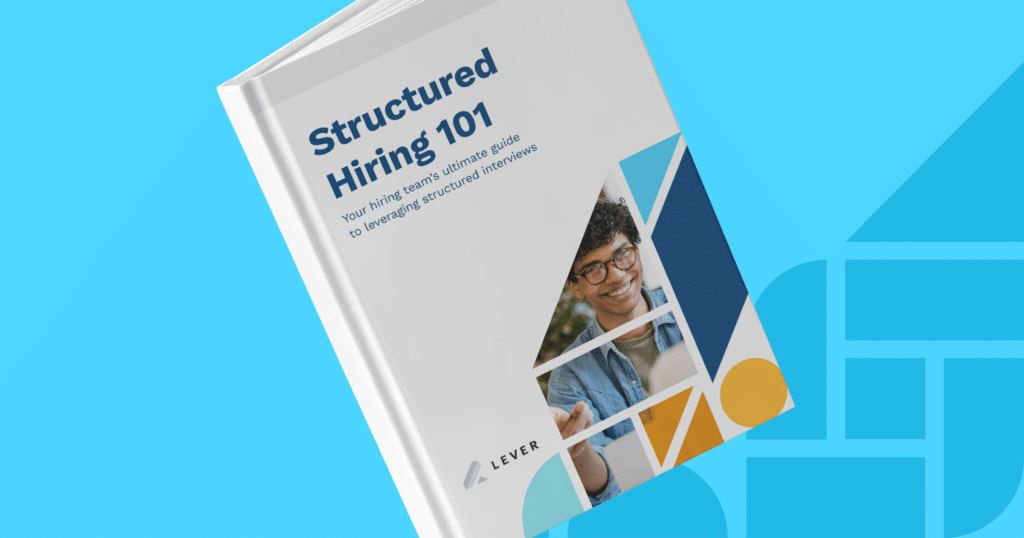- Building your DEI tech stack
- Start with sourcing, job distribution,
and referrals - Creating inclusive job descriptions
- Application reviews and screening tools
- Reference checks and background checks
- Individual interviews and panels
- Candidate assessments and tests
- Data and insights visualization
- Continuous nurture post-hire
- Create inclusive communities
- Promote pay equality across your organization
- Make your recruiting process
a foundation for change with Lever
Building your DEI Tech Stack
When building a strucorgntured hiring process for any modern organization, it’s imperative you integrate diversity, equity, and inclusion (DEI) into your recruitment strategy. Given the critical role that talent acquisition and recruitment play in the growth of your company, a well-rounded, DEI-focused recruiting process will help to eliminate bias and nurture a more inclusive talent acquisition program.
However, as your organization and recruitment efforts scale, your recruitment teams will inevitably look to add more tools to their suite to help them achieve their goals — ones that support your company’s vision for DEI and recruitment initiatives. This series of integrations is what can ultimately make up your DEI tech stack, and it’s vital to your recruiting team’s success and candidate experience.
At Lever, our platform helps you take a more inclusive approach to recruitment that’s both data-driven and objective. While there isn’t one solution that will help you accomplish all of your DEI objectives, our growing integration ecosystem seamlessly integrates DEI tools with Lever, empowering your teams to nurture that inclusive and fair recruitment program your organization needs.
With innovation in the DEI space comes new integrations and opportunities to drive your inclusive hiring strategy forward. In particular, there are 7 key areas where consistent improvement can help increase equity in your hiring process:
- Sourcing, job distribution, and referrals
- Job descriptions
- Application reviews and screening tools
- Candidate assessments and tests
- Individual interviews
- Data and insights visualization
- Post-hire initiatives
Like any organization, your inclusive hiring strategy will be tailored to your needs, and the same can be said for the tech and tools your recruiting teams use to keep your company’s DEI goals on track. Once you’ve developed or optimized your recruitment strategy, you’ll need the right tools that will comprise your DEI tech stack. The question is, what tools can you use, and how can they support the growth of your strategy?
Maryam Jahanshahi, PhD
Cofounder and Head of Science, Datapeople
Equity in recruiting begins with organic candidates: people who find your job post using a job search engine or a career site. And small changes to job titles, responsibilities, and even perks have a meaningful impact on who feels welcome to apply.
First, let’s consider why diversity hiring is important
When it comes to attracting and retaining top talent, diverse and inclusive organizations are leading the charge. But diversity hiring isn’t just important to hiring managers and recruiters—in fact, 67% of employees consider workplace diversity an important factor when accepting an offer of employment, while diverse workplaces have been shown to improve retention across nearly all employees in an organization.
At the same time, studies have proven that diverse companies are 70% more likely to capture new markets and inclusive organizations are 120% more likely to hit their financial goals. Having a diverse team of talent enables companies to not only better understand and support those with diverse perspectives, but build a robust candidate pool and recruiting pipeline of diverse talent.
And, with this diverse talent comes a wealth of new ideas, perspectives, experiences, and opportunities to grow your organization while improving your strategies for diversity hiring. That’s where your DEI tech stack comes in.
Getting started with a DEI tech stack
A strong DEI strategy and tech stack aren’t created overnight, especially as your recruitment needs grow and you scale your talent acquisition pipeline. Knowing what those recruitment needs are, and your TA priorities will inform your approach to choosing the right tech to further your DEI efforts.
To ensure you’re choosing the right tools, and not simply adding more tools, consider evaluating the necessary additions to your DEI tech stack against the following criteria:
- Fair, equitable, and unbiased
- Data and insights-focused
- Alignment with your recruiting strategy
- Continuity and longevity post-hire
You’ll notice that we call out continuity post-hire—and for good reason! Any tool you add to your DEI tech stack should be intentional but also enable your recruitment teams to continue working on DEI initiatives beyond the hiring phase. This means that your DEI tools or any diversity tech you use should support both recruiters and successful candidates even after they’re hired and onboarded.
Bearing in mind the 7 key areas where a DEI tech stack can benefit your recruitment strategy most, we’re going to break down how to create a DEI tech stack, along with partner tools you can use and questions you should keep in mind as you develop your stack.
A core part of your recruitment strategy is attracting, nurturing, and hiring top talent for your organization. However, it’s tempting to default to using the same channels when sourcing candidates or posting open roles. To ensure you’re broadening your search and exposure, leverage new channels or tools that open the doors for a more diverse talent pool.
To do that, your primary focus should be job distribution and referrals. Let’s break down how you can integrate DEI into both.
Start with sourcing, job distribution, and referrals
Referrals
It’s common among many organizations to offer incentives or rewards for internal referrals, encouraging existing employees to refer qualified candidates from their personal or professional networks for open roles at your company. However, referrals like these can be ineffective from a DEI standpoint—in many cases, people tend to refer candidates they have a personal connection to or close friends. As Payscale’s report found, these types of referrals can result in biased and often inequitable candidate pools.
The solution? Make your referral programs external. By using tools that expand your company’s referral network beyond those of your employees, you create more opportunities for candidates from diverse backgrounds, perspectives, and skill sets. Additionally, an external referral tool can help you eliminate bias towards certain candidate pools, and may encourage employees to think about their networks and how they can foster more diversity and inclusivity in those they connect with or refer.
There’s likely to be diverse talent in your existing employee network. However, it’s important to intentionally ask for connections to these potential candidates to ensure a diverse pipeline. Teamable augments self-reported data in order to make it easy to enjoy the fruits of referrals while still retaining a commitment to diversifying your workforce
Job Distribution
When distributing open roles with your organization, you’ll want to get those roles in front of a vast and diverse range of talent. Above and beyond using platforms like LinkedIn to advertise those positions, having alternative outlets through which you can share those roles is critical.
Diverse distribution
Your recruitment pipeline may reveal key areas or gaps in which you need to improve or increase representation—but it can be challenging to do that with basic recruiting platforms. Instead, harnessing platforms like Jopwell allows you to get your open roles in front of more diverse communities of candidates while representing your organization as an inclusive place to work with equitable hiring practices. By leveraging these communities, you’re also making an effort to meet candidates where they already are, in turn making it easier for diverse talent to find you.
Creating inclusive job descriptions
In job descriptions, words matter. And following through with the descriptions you use matters, too. The language and tone you use in your job descriptions can quickly deter candidates from applying to your organization, especially if the language isn’t inclusive.
Fortunately, some tools can help you analyze and optimize the language you use when crafting your job descriptions, especially if you’re aiming to use impact descriptions as we do here at Lever. These tools are valuable additions to your DEI tech stack as they can show you discrepancies or red flags that have the potential to offend, confuse, or bias candidates. Over time, these tools can also help recruiting teams recognize problematic content or language.
Keep in mind that your job descriptions should also be inclusive of candidates with disabilities, both seen and unseen. By ensuring your language is inclusive of everyone, you’ll attract a wider range of skilled, qualified talent.
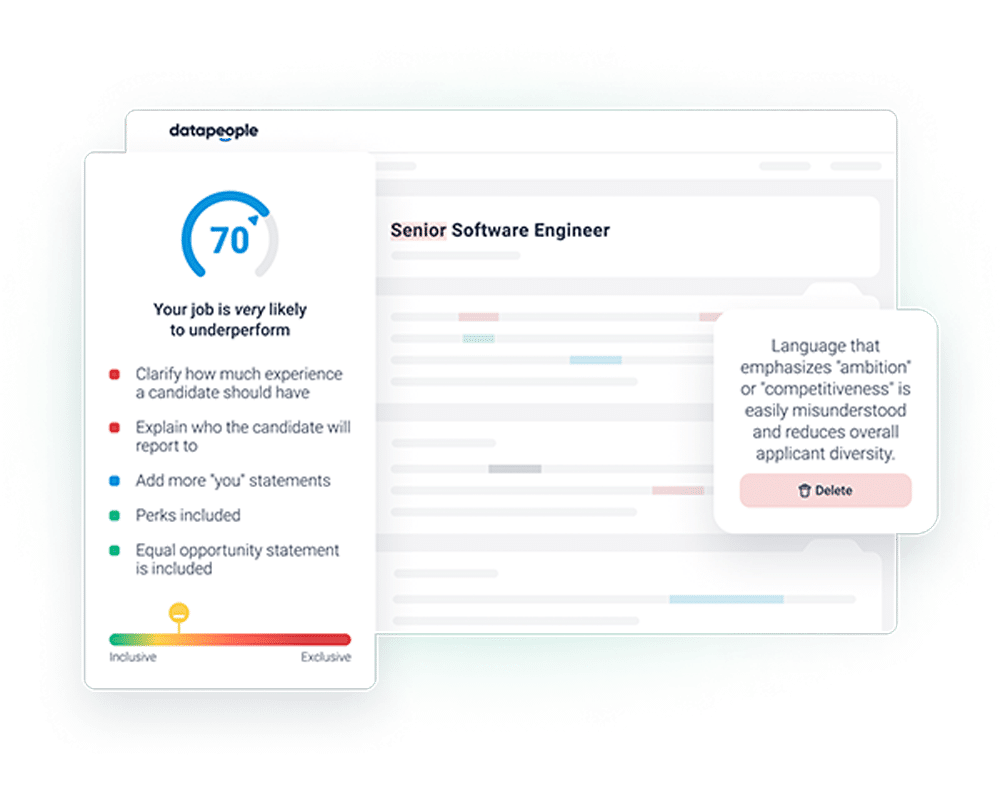
Datapeople is a great platform for this very reason. With our Datapeople integration, you can write and optimize job posts using language analytics that help you make more inclusive and fair decisions in how you craft descriptions and recruitment communications.
Impact descriptions
It’s safe to say that traditional job descriptions are no longer effective in capturing candidate interest in your company—but, more than that, they can also lack detail and inclusive language. Enter impact descriptions.
Impact descriptions forego the traditional list of responsibilities in job postings in favor of outlining what the candidate can expect to learn, own, and improve once they’re in the role, with a focus on bringing someone’s unique perspectives and experiences to the job. Impact descriptions outline how the role and responsibilities will progress over time, and can even include development timelines. They also focus on the benefits of working at an organization, not just the features or tasks of a role.
From a DEI perspective, impact descriptions consider a range of factors that help organizations find the best candidate for the role—as opposed to relying solely on whether someone’s professional background matches a list of responsibilities. By outlining how people will learn, grow, develop, and work within a company, these descriptions allow for a more diverse range of candidates to apply. Consider using an integration that optimizes your impact descriptions to be more inclusive and fair.
PARTNERS TO EXPLORE
Application reviews and screening tools
Whether you’re high volume hiring or have multiple open roles at one time, you’re likely looking for new ways to streamline the screening process for efficiency. Today, there are a myriad of diversity hiring tools that can help you shortlist candidates or cherry-pick those who are best suited to a role—but sometimes, these tools can amplify bias if used incorrectly, which means your recruiting teams must be discerning in the applications or integrations they add to your DEI tech stack.
Anonymous candidate screening
To avoid bias in your application reviews and screening process, consider using an anonymous candidate screening tool or integration that works with your ATS to screen applicants, rather than shortlisting people manually. Various integrations, like MeVitae, redact resumes to help eliminate bias from the review process.
Similarly, other integrations like Criteria or Eightfold use anonymous candidate screening paired with data to help you eliminate unconscious bias by matching candidates with the specific skills and experience you’re looking for.
Other tools like Bryq allow you to screen candidates anonymously by looking at both personality traits and cognitive abilities, considering a wide range of applicants so that no talent goes unturned and diverse candidate pools aren’t missed. Additionally some web browser extensions hide names and photos on social profiles so that you can avoid bias and focus instead on the attributes that truly matter when recruiting top talent.
Ultimately, any tool you add to your DEI tech stack that assists with screening and application reviews should help to eliminate unconscious bias. Consider asking yourself the following when evaluating a screening tool to add to your DEI tech stack:
- Is the tool transparent and fair in how it screens and reviews applications?
- Does the AI/ML model used in the tool take into account representation of broader diverse groups, including candidates with disabilities?
- How does the tool ‘score’ or ‘qualify’ candidates and applications?
- Does the tool give clear explanations as to how it screens then qualities candidates, especially if it uses AI?
- How does the tool’s AI algorithm protect against inherent biases in AI?
Reference Checks and Background Checks
Reference and background checks are typically the final steps in a candidate’s hiring process before a recruiter extends a job offer. They help hiring teams further assess a candidate’s qualifications and verify the information the candidate has shared about previous roles and employment experiences. Not only that, but reference checks can be leveraged as an additional opportunity to gather insights about a candidate that help teams make the right hiring decisions, especially if your team is torn between two candidates. As for background checks. these are a standard step for virtually every organization. However, not all reference checks and background checks are created equal.
Conducting fair reference checks
It’s not uncommon or unheard of that recruiters ask previous employers questions related to the candidate on a personal level rather than focusing on learning more about their skills, qualifications, employment history, and experience. The goal is to use reference checks to better understand whether a candidate will be a positive addition to your team based on attributes and skills that are relevant to the role in question.
In this sense, any reference checks you conduct should be done so objectively, so that your hiring team can make bias-free decisions about a candidate and their ability to succeed in a specific role.
As Mike Fitzsimmons, the CEO of Crosschq says, “Fair reference checks are critical to the recruiting process—they allow companies to objectively compare and make bias-free determinations as to whether your candidate has the right skills and attributes to succeed in the role. To ensure reference checks are conducted fairly, questions should be asked of each reference in the same format and focused on the skills and attributes that are relevant and essential to the specific job.”
This is similar to structured hiring and interviewing, where standardized questions are asked in the same order and assessed using the same criteria to ensure that each candidate is being assessed fairly. You can take the same approach with your reference checks for a more equitable process.
As an example, Crossschq 360 uses standardized questions developed by leading psychologists for reference check surveys, which help reduce unconscious bias and ensure fairness and equity during recruitment while increasing hiring from underrepresented groups.
Mike Fitzsimmons, CEO, Crosschq
When reference checks aren’t done fairly, companies run the risk of serious compliance issues that expose the organization to a laundry list of anti-discrimination laws, as well as doing your company the disservice of losing out on a potentially excellent candidate (or hiring one that won’t be successful).
How can background checks be leveraged for equitable hiring?
The United States has nearly 25% of the world’s prison population, despite only making up close to 5% of the global population. One in three, or nearly 77M, people in the United States has a past criminal record. Contrary to mainstream misperception, this large and diverse community includes a wide array of ambitious people who have the grit, talent, and loyalty. Yet they are consistently overlooked for jobs and career growth because of their past criminal record alone. By any reasonable standard, this does not increase safety and certainly is not beneficial to individuals, families, or businesses.
How can your hiring team conduct fair background checks?
Checkr defines Fair chance hiring means giving individuals with prior convictions or arrests a fair chance in the hiring process. It isn’t a black-and-white approach, but a more equitable and measured way of evaluating candidates to discourage hiring discrimination. A fair chance hiring process means looking thoughtfully at your hiring and adjudication criteria, removing bias, and being open to hearing the context and any remediation around a candidate’s criminal background before making the final decision. It is one step organizations can take to become more equitable when conducting fair background checks.
Ken Oliver, Executive Director, Checkr
Fair chance hiring presents a unique opportunity for businesses navigating the workforce in the wake of the pandemic. Hiring workers with conviction histories not only creates a more inclusive, diverse workforce, it unlocks a powerful talent pool. System-impacted individuals are a proven asset for teams and employers as a whole—their perspectives and experiences can shape and improve business outcomes and they are committed to the work they’re doing and to the companies they serve.
Individual interviews
and panels
Throughout the hiring process, your team will interview candidates both individually and in some cases, in a panel setting, where multiple team members have the opportunity to meet with and speak to the candidate. In both instances, candidates should be measured against the same criteria while explaining why a team member is measuring each candidate in a certain manner.
To mitigate bias and subjectivity, ensure the tools you use in individual and group interviews prepare you with the right questions to ask and the same measuring or ‘scoring’ model that every team member follows. This allows your team to make hiring decisions based not on subjective opinions but, rather, the criteria and needs of the entire team.
For example, PredictiveHire lets you perform anonymous top-of-funnel interviews, effectively eliminating bias among team members as well as recruiters. Goodtime empowers you to diversify your panel interviews so you can mitigate any unconscious biases in group interviews or presentations.
With Lever, you can conduct both individual and group interviews using our structured interview kits, along with hidden feedback that’s only visible to your teams once all members have submitted their feedback. Additionally, our integrations (like MeVitae) support anonymous resume reviews, making it easier to focus on DEI best practices in your interview processes.
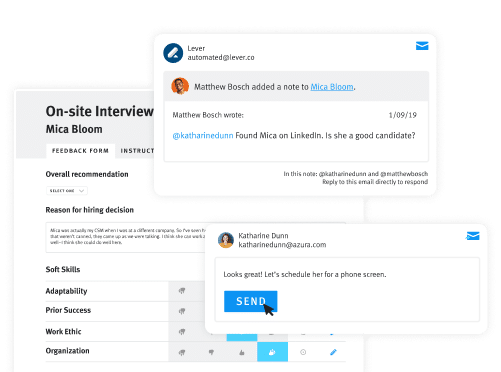
PARTNERS TO EXPLORE
Candidate assessments and tests
Candidate assessments have traditionally been part of the interview process, allowing recruiters to gain a better, more in-depth understanding of a candidate’s hard and soft skills, along with their approach to problem-solving and strategy. The benefit of candidate assessments is providing your talent acquisition teams with an unbiased way of evaluating a candidate’s capabilities, while also unearthing unique talents or skills that may not show solely through a resume or application screening.
For example, tools like Bryq use your job descriptions to create a profile of skills, capabilities, and personality traits that candidates will need for the role, and assesses candidates based on that profile. This breeds objectivity while anonymizing candidates so that subjective bias doesn’t interfere with your recruitment process.
In instances where you need to hire for hyper-specific skills, like coding or programming, you’ll need a tool that allows you to objectively assess candidates against particular skill sets while anonymizing applicants for more inclusive hiring. Platforms like Codility do just that, so you can build more diverse and equitable teams of highly-skilled top talent.
Marlina Kinnersley
CEO of Fortay
Don’t forget about company culture, specifically your core values. Talent Acquisition teams have a responsibility to uphold your culture but find it challenging to hire for values in a data-driven way fairly and consistently at scale. Diverse values-aligned teams always perform better.
Considerations for culture-add
You’ll also assess candidates for other factors, such as culture or value alignment. This means determining how candidates will add to and improve upon your company culture by bringing their unique perspectives, experiences, backgrounds, and skills to the team. Partners like Fortay can help you assess culture-add in a way that is inclusive of underrepresented groups and talent pools.
Bryq’s Culture Add indicator feature can also assist with gauging the culture-add of a candidate. With this feature, employers and recruiters can discover employees in their candidate pools who would not only fit into their company’s culture but would add to it in areas where they are lacking.
Before adding an assessment tool to your DEI tech stack, evaluate each tool against questions like:
- What model does the tool use to assess candidates?
- Are the scoring or qualifying questions or tasks representative of everyone, and how does the tool ensure the assessment avoids unconscious bias?
- Does the tool allow for candidate anonymity?
- Can the tool accommodate candidates with disabilities, such as sight or hearing impairment?
- How consistent is the scoring or measuring model?
PARTNERS TO EXPLORE
Data and insights visualization
As your company scales and your recruitment teams pursue deeper DEI initiatives, you’ll need the ability to measure the impact of those initiatives on your hiring process and gauge where your organization can continuously improve DEI. Beyond that, having a holistic understanding of how your talent acquisition strategy is performing, and whether your teams are achieving their DEI goals will help propel your teams—empowering both recruiters and candidates to succeed.
At Lever, we offer tailored talent analytics that enable you to measure the diversity and equity of your talent pipeline, to help you understand where you can improve upon DEI in your recruiting program.
In addition to our talent analytics suite, we also offer various partner integrations to elevate your data visualization and give you even more visibility into the value of your pipeline and hiring process. For example, TopFunnel pairs with Lever so you can make data-driven decisions that eliminate bias in hiring while gaining deeper insight into your talent pipeline through ATS metrics, sourcing distribution, recruitment campaign statistics, and more.
By understanding your DE&I sourcing efforts from first point of outreach (TopFunnel) through the funnel (Lever) you can ensure proactive outreach to diverse communities, resulting in a more diverse workforce.
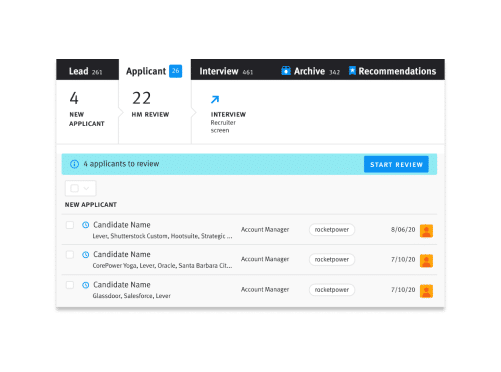
Searchlight allows you to use past performance data to make more informed hiring decisions while translating skills between roles, helping you source talent from diverse and underrepresented groups.
Prior to onboarding a data and analytics integration or tool with your DEI tech stack, ask yourself:
- Does the tool work in tandem with our existing applicant tracking system, and does it compliment the data we already have?
- What data and insights can we gather using this tool that we can’t gather with our current recruitment software?
- How can the tool scale with us and our applicant tracking software as our company grows?
- Is the tool or integration transparent in how it collects data and its parameters for diversity, equity, and inclusion data?
PARTNERS TO EXPLORE
Continuous nurture post-hire
What happens once you’ve filled an open role and the new hire is onboarding with your organization? Though DEI plays a role in your hiring process, it’s important that it remains a part of your post-hire plan, too. This means ensuring that your DEI tech stack includes tools and resources that recruiters and teams at large can leverage to create more inclusive work environments — both in-person but especially remotely — that help new hires better transition into their roles while feeling included among their new peers.
Focus on sentiment and engagement
It’s not uncommon for new employees to feel overwhelmed by their onboarding process, but recruiters are not the only team members responsible for fostering an inclusive onboarding experience for new hires. This is where sentiment and engagement with post-hire experiences come into play.
Starred helps you create surveys from scratch (or using pre-built templates) that you can use to gather feedback from new hires, driving insights into onboarding, engagement, and sentiment. You can continue leveraging these surveys to engage employees post-hire and post-onboarding to garner valuable feedback that informs your recruitment strategies going forward.
Fortay lets you send employees quick pulse surveys that provide powerful analytics across the talent lifecycle around engagement, inclusion, belonging, wellbeing metrics, giving you actionable insights into how your diverse workforce or underrepresented talent feel about their experiences at your organization and understand your gaps.
Collecting insights around diversity recruiting from both employees and candidates is critical. Through LeverTRM, for example, a recruiter can request and asses feedback from EEO surveys and dashboards to better understand the diversity of their pipeline and pivot their strategy if the data shows a lack of diversity, or bias in various stages of the recruiting process.
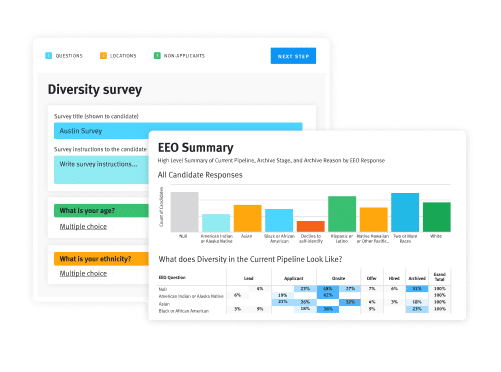
Questions to ask when adding an engagement tool to your DEI tech stack:
- Does the tool allow for anonymized surveys and submissions?
- How does the tool protect the privacy of employees and new hires who interact with surveys, polls, and feedback activities?
- Does the tool integrate with our other tools, such as Slack, Teams, or Lattice?
- What data and insights can we gain from using the tool?
- Can the tool be used during and post-recruitment, for candidates and employees alike?
Create inclusive communities
In many organizations, employees will create their own groups based on shared interests or experiences, which can include race, gender, age, mental health, and more. Known as ERGs (Employee Resource Groups), these groups help organizations recruit top talent from diverse candidate pools and underrepresented groups by learning from existing employees who leverage these groups as a resource for culture, inclusivity, and a sense of belonging.
When creating your DEI tech stack, it’s imperative that your tools support these groups. Slack, a collaborative workplace communication tool, allows you to create custom private or public channels that employees can use as a safe place to share experiences and support. Especially critical for remote teams, Slack enables teams to connect through chat and video, making it easy for companies to create ERGs.
Similarly, Phenom lets you create virtual communities that you can leverage as ERGs, with additional capabilities of sharing resources and promoting ERG-specific events. With an integration like Phenom, both recruiting teams and employees can nurture inclusive workplaces, whether in the office or fully remote.
When considering a collaborative communication integration for your diversity tech stack, consider the following questions:
- Does the tool or integration protect our employees’ privacy?
- How does the tool function with our existing recruitment software and applicant tracking system?
- How inclusive is the tool of minority or underrepresented groups, such as LGBTQ+?
- Does the tool offer any data, analytics, or insights into an ERG’s impact on our DEI initiatives?
Caitlyn Metteer
Senior Manager, Recruiting, Lever
One of a recruiter’s greatest assets is the tech stack they use to help recruit, nurture, and hire top talent. Leveraging tools and integrations in that tech stack that help diversify your pipeline and promote inclusivity in your hiring process is essential to any well rounded DEI strategy.
Promote pay equality across your organization
Many organizations benchmark salaries and pay scales against their market, but this is only the first step in working towards equalizing compensation within your organization. Factoring pay equality into your DEI tech stack is the next step, beginning with data and insights around equality and diversity across your company.
Orgnostic leverages people analytics to give you deeper insights into your employees, including diversity, equity, and inclusion. With Orgnostic, you can ensure you’re promoting employees objectively while offering equal compensation regardless of factors like gender and ethnicity. The tool also provides insights into distribution of roles and compensation among minority groups like women, by integrating with Lever seamlessly. Additionally, Orgnostic allows you to better understand the sentiment around these key areas of employee development, like salaries and promotions.
For example, you can track the complete employee lifecycle from the recruitment phase until your employees leave your company. This makes it easy to spot whether the pay differences between some of your employee groups are significant, but also to provide insight into what might be causing the gap —like promotion speed, hike amounts, grade or age at hire, types of roles minority employees are hired into, or all together.
Figure, another helpful DEI tool for your tech stack, performs as a compensation management system, using data and analytics that help you detect pay inequity in your organization. Integrating with applicant tracking systems like Lever, you can use Figure to ensure your compensation practices are fair for all.
Before integrating a compensation tool into your DEI tech stack, ask yourself the following:
- How deep are the data and analytics the tool gives us access to?
- How does the tool detect and determine pay inequity or compensation gaps?
- Does the tool complement our existing applicant tracking software?
- Does the tool provide actionable insights across different gender, age, and ethnicity groups, including those with disabilities?
Make your recruiting process a foundation for change with Lever
At Lever, we continue to invest in innovative partnerships for our ecosystem of integrations and tools. As the only ATS + CRM, we’re committed to providing you with the tools and resources you need to recruit, nurture, and retain top talent in your organization. To explore all of our integrations, check out our full ecosystem here.
Curious how Lever can help you elevate your DEI initiatives and make your recruiting process a foundation for change? Download our 2021 State of Diversity, Equity, and Inclusion Report below.
